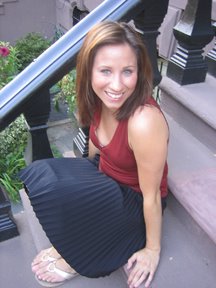Queens, New York, December 1978. I was born too early and too small. Weighing just shy of four pounds, my father said I looked like a chicken. My mother said I looked like a china doll. I’m not sure what my three-year-old sister thought of me, but I’ve heard stories about toddlers trying to put their new siblings in the trash.
Elementary school started out okay. I have a few select memories from kindergarten: a student’s grandfather, an Italian chef, coming to our class to cook squid on a hot plate; building a toy car out of pieces of wood; and putting milk money into a very, very small brown envelope.
The next few years were mostly all right. The highs included: performing as Jackie and the Beanstalk in a third-grade play, reading Choose Your Own Adventure books (and always cheating), and getting up to “knee-zies” in Chinese jump rope. The lows included: hiding in the bathroom whenever math homework was collected in the fifth grade, frequent feelings of déjà vu, and being told I had “skeleton hands” by the boy I had a crush on.
Sixth grade was the beginning of a new era—private school—where the classes were small and my inability to do math was quickly discovered. This is also when I wrote my first short story. It was based on an old photograph of my mother’s—a man and a woman standing in the woods with their backs to the camera.
My teacher gave me an A, something I didn’t often get. My parents went crazy for the story, and my seeming maturity. The consensus was that I had talent.
At some point in high school I started keeping a journal (not to be confused with the pink diaries with heart shaped locks that I had had before). Every few months I’d go to the drug store to buy a new marble composition book. I’d spend a lot of time decorating the cover with stickers, drawings, photos, and cut outs from magazines. And when I thought the cover was sufficiently cool, I’d start writing in it.
When I was a senior in high school, I took AP Writing. Our teacher required us to write ten journal pages a week. I think I was one of the few in the class who didn’t mind. But by then I was already a journal addict. I couldn’t go anywhere without it. And if I left my notebook at home by mistake, I would write on scraps of paper, napkins, my hand, anything. (This was also the year I discovered Anais Nin--the undisputed queen of journal writing.)
There were two things I loved most about having a journal. The first was that it filled my time. Waiting for a train? No problem. Stuck on the bus? All set. Trying to ignore my classmates during my free period? Super.
The second thing I loved was how my journals felt. Not the weight of the book, but the pages. I loved running my hands over my writing, over the impressions made by my pen. It was like my own version of braile.
When I was ready to begin writing I Don’t Want to Be Crazy, my memoir about anxiety disorder, I took out my journals from senior year of high school through the year after I graduated college. I thought that transcribing all the entries about anxiety would be easy--that there would be enough to fill a book. I was so wrong. My journals from freshman year had almost nothing about anxiety--ironic since I thought I was losing my mind.
Things didn’t look so easy anymore. I needed a new plan. Instead, I used my journals to help me recreate my world. They reminded me who I was friends with, what types of parties I went to, and what classes I was in. Other journals were more helpful—especially the ones from when I was studying abroad in Paris my junior year. Those journals were far more explicit about my anxiety. For the first time, I could actually lift entire poems from my journal and use them in my book (with much editing, of course).
One thing that I noticed throughout all my journals was a constant self-awareness of their significance. I would often scold myself as I wrote: “Must write neater. This is going to be important.” I had always fantasized that one day my journals would be published—although, I was fairly certain that I would have to die tragically first.
Thankfully, that didn’t happen. I Don't Want to Be Crazy came out in July 2006, and I'm still here. I live in New York City and work as a children’s book editor at a publishing house. I still write in my journal whenever I can.




